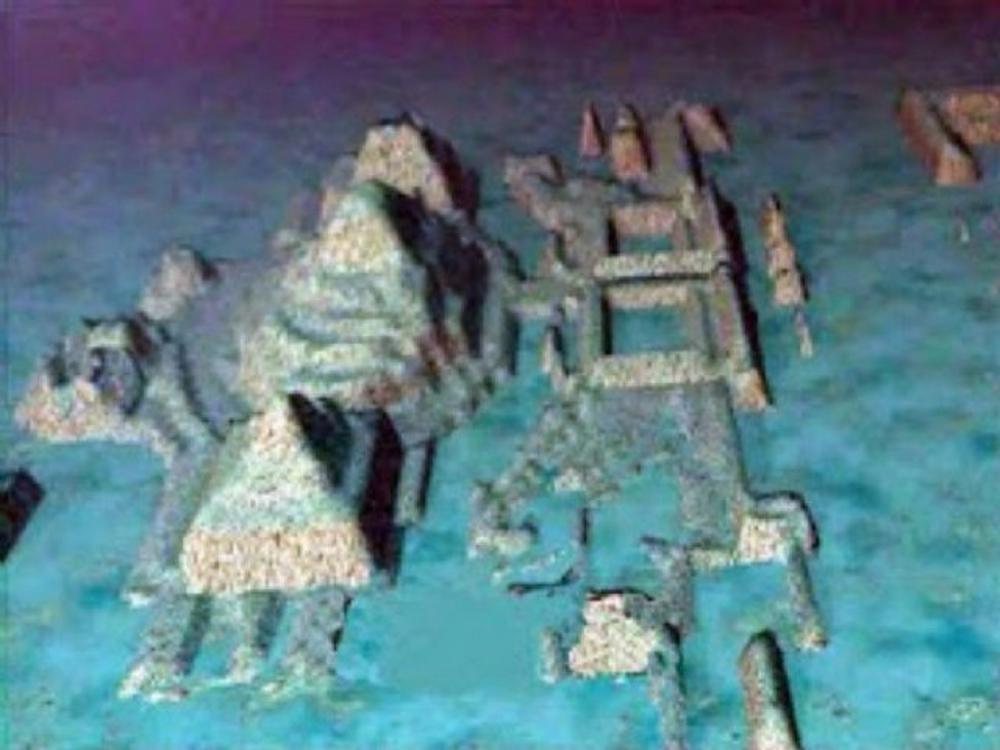What Happened to the Underwater Cuban City That Is Older Than the Great Pyramids?
Two decades ago, researchers working off the coast of Cuba came across the remains of an ancient underwater city that later proved to be older than the Pyramids of Giza.
The structures consist of enormous stone blocks, some of which are geometric and stacked similarly to other pyramids in the Americas. To this day, the site remains a mystery, with some suggesting it could be a lost civilization, whereas others argue it’s the remains of the fabled Atlantis.
Survey Team Works With Fidel Castro
More than 20 years ago, researchers from Advanced Digital Communications (ADC), a Canadian company, were scanning the waters off the tip of the Guanahacabibes Peninsula close to Cuba when they came across a fascinating discovery.

Source: Wikimedia
The team was headed by marine engineer Pauline Zalitzki and her husband Paul Weinzweigl, owners of ADC. Their company was working alongside four other firms on behalf of Fidel Castro’s Cuban government to explore the treasure-laden shipwrecks, many of which date back to the Spanish colonial era.
The Lost City of Cuba
Dubbed “the lost city of Cuba,” it has been discovered that the features of the stones are quite old. They are older than the Great Pyramids in Giza with experts dating the structures to be more than 6,000 years old.

Source: Andrew Wragg/Flickr
The team of researchers suggests that humans likely built the structures on dry land. Over time, rising sea levels swallowed the structures, completely submerging them under the waves.
Discovery of an Urban Settlement Beneath the Waves
The results of their sonar scans revealed the remains of what appeared to be an urban settlement, complete with smooth and aligned stone blocks, many of which were placed in a geometric formation.

Source: Wikimedia
Zalitzki returned to the site the following year to conduct further investigations alongside her husband and expert geologist Manuel Iturralde, who was a senior researcher at Cuba’s Natural History Museum, per Ancient Origins.
Further Investigations at the Underwater Site
During their second visit to the site, the researchers brought a Remotely Operated Vehicle with them, which allowed them to get close to the structure and photograph it. The images later released to the public show what appear to be enormous blocks of granite.

Source: Wikimedia
The largest of the blocks measured 8 feet by 10 feet and appeared to have been carefully placed atop one another. At the time, Zalitzki suggested the images could be evidence of an ancient submerged city; however, she claimed more evidence was necessary.
Ruins of a 50,000 Year Old City
Iturralde, a geologist who had spent considerable time studying underwater rock formations, said, “These are extremely peculiar structures, and they have captured our imagination. But if I had to explain this geologically, I would have a hard time.”

Source: Wikimedia
According to Iturralde, it would have taken as much as 50,000 years for such a structure to sink to this depth. He added, “50,000 years ago, there wasn’t the architectural capacity in any of the cultures we know of to build complex buildings.”
Extensive Urban Settlement
Speaking with the Florida Sun-Sentinel in 2022, Weinzweig said, “The structures we found on the side scan sonar simply are not explicable from a geological point of view.”

Source: Freepik
According to the researcher, it may have once been an extensive urban settlement. He added, “It’s a really wonderful structure which really looks like it could have been a large urban center. However, it would be totally irresponsible to say what it was before we have evidence.”
The Discovery Sparked Debate
The discovery of the formation led to a controversial debate. Some people claimed it was the remains of the mythical city of Atlantis first mentioned by Plato in his work Timaeus and Critias. However, several experts from the archaeological community remained skeptical.

Source: Freepik
Iturralde later suggested the volcanic rocks, which make up the bulk of the site, were once above water at a distant part in the past. However, he was completely sold on the idea that it was the product of an ancient civilization, stating, “Nature is much richer than we think.”
Remnants of a Local Culture
Despite the interest in the site and media companies pushing the Atlantis theory, Zelitsky and Weinzweig steered clear of making similar assumptions.

Source: Wikimedia
Zelitsky said the Atlantis story is a myth. “What we have found is more likely remnants of a local culture,” once located on a 100-mile “land bridge” that connected Mexico’s Yucatan Peninsula to Cuba.
Local Legends
Iturralde said local legends of the Maya and groups native to the Yucatan region speak of an island where their ancestors once thrived before it was swallowed by the year.

Source: Wikimedia
It’s quite possible the sunken settlement may have once been the home to one of these groups before some natural calamity sent it to the bottom of the ocean. However, not everyone agrees with their theory, which suggests the formation is anything more than natural rocks.
Bad Archaeology
Keith Fitzpatrick-Matthews, who worked for the debunking website Bad Archaeology, suggested there were several problems with the settlement theory, the largest of which was the depth at which it was found.

Source: Freepik
According to the researcher, this supposed settlement could not have been the capital city of Atlantis, as it hasn’t been above sea level since well before the ice age.
The Sunken City is Not Atlantis, Says Researcher
According to Fitzpatrick-Matthews. “At no point during the Ice Age would it have been above sea level unless, of course, the land on which they stand has sunk. This is the claim made for Atlantis: according to Plato’s account, it was destroyed “by violent earthquakes and floods”.

Source: Wikimedia
He continued, “However if we take Plato at his word—as we must if we assume Atlantis to have been a historical place—the violence of its sinking makes it improbable that an entire city could have survived plunging more than 600 m into an abyss.”
Was the Lost City Ever Above Sea Level?
Many experts have largely disputed the suggestion that “the lost city of Cuba,” located off the Guanahacabibes Peninsula, was above water 6,000 years ago.

Source: wirestock/freepik
Fitzpatrick-Matthews notes that the sea levels dropped by only 328 feet during the Pleistocene era, which spanned from about 2.5 million to 11,700 years ago. The stones would not have been above sea level unless the land beneath them sank.
The Hole in the Lost City Theory
Iturralde also points out that the depth of the stone structures is also problematic and serves as evidence against the “sunken lost city” theory.

Source: Freepik
According to his research, which is based on the maximum speed of the planet’s tectonic plate movement, it would have taken more than 50,000 years for the stones to have sunk as deep as they have.
The Structures Are Out of Place and Time
Fitzpatrick-Matthews and Iturralde are not the only ones who question the validity of the “lost city of Cuba” theory. Michael Fougth, an expert in underwater archaeology at Florida State University, shares in the skepticism.

Source: Pixabay/Pexels
“It would be cool if Zelitsky and Weinzweig were right, but it would be real advanced for anything we would see in the New World for that time frame,” Fought said. “The structures are out of time and out of place.”
How the City May Have Sunk
While the “lost city of Cuba” may have not sunk 2,000 feet below the surface hundreds of thousands of years ago, there could be an explanation as to why this structure is now swimming with the fishes.

Source: Wilson Malone/Pexels
An earthquake or volcanic activity may cause a cataclysmic event that sent the ancient city underwater. It’s a theory we have heard before from the famed Greek philosopher, Plato.
No Modern Investigations at Underwater Site
Despite all of the attention the site garnered over two decades ago, it has received little to no follow-up investigations, leaving many to wonder what really lies beneath the waves close to Cuba.

Source: Wikimedia
However, if the stones were merely the product of nature, it should have been fairly easy to explain what natural process led to their creation. As things stand, the story went cold after experts dismissed Zelitsky’s theory.
A Natural Land Road
The theory of the structure being a land bridge wouldn’t be too far of a stretch. Most geologists and archaeologists now believe that famous land roads like the Bimini Road are natural features that formed with bedrock fractures that created long, clean lines.

Source: Francesco Ungaro/Pexels
John Echave, a senior editor at National Geographic, stated that a team of highly skilled divers will need to study the stone features to find out if these rocks are naturally occurring. “They are interesting anomalies, but that’s as much as anyone can say right now,” Echave added.
Not a Natural Phenomenon
However, many don’t believe these granite blocks could be a naturally occurring phenomenon. The sharp corners and right angles have led many to believe that these stones were shaped by tools to form geometric shapes.

Source: Pixabay/Pexels
To the experts, the stones have been organized in a way that is like urban development with many granite slabs stacked upon each other to form a pyramid-like structure.
Too Much Organization Behind the Structures
According to Weinzweig, “There is too much organization, too much symmetry, too much repetition of form.”

Source: Wikimedia
Zelitsky cautioned that it is too early to conclude the stone structures or their purpose long before sinking into the ocean. However, she is excited about the possibility that the discovery could be significant to human history.
Moving Around the Red Tape
There have been several planned dives and expeditions to the site, but each one has been canceled for several reasons. Many of the expeditions cited the lack of funding as the reason why they canceled the journey to the “lost city of Cuba.”

Source: Oleksandr P/Pexels
The Cuban government called off the other expeditions due to red tape. A blockade around the site and the rejection of permit applications from research teams have prevented further exploration.
Ready to Study the Site
But hope to study the site has not been lost. Zelitsky, Weinzweig, and their colleagues are eager to get a dive team in the water to prove that an advanced and highly skilled civilization once flourished in Cuba.

Source: Wikimedia
Weinzweig asserts that the discovery of significant archaeology in the little-explored world’s oceans will greatly expand our understanding of human civilization’s enormous antiquity.
Other Lost Cities Below the Surface
“The lost city of Cuba” is not the only amazing underwater city discovered. Off the coast of Japan’s Ryukyu Islands, the Yonaguni Monument stands underwater shrouded in mystery and controversy.

Dwi sumaiyyah makmur/Wikimedia Commons
Scientists believe that the pyramid-shaped structure, an arch, staircases, and other shapes marked with ancient script, which submerged nearly 10,000 years ago, were man-made. However, others argue that these structures are naturally occurring like the symmetrical basalt columns in Iceland or on the Gaint’s Causeway in Northern Ireland.
The Riches of Thonis-Heracleion and Alexandria
The long-lost Alexandria has as many legends and mysteries surrounding it as Atlantis, but two ancient underwater cities showcase the remains of the lost city. A few feet off the coast, explorers found 2,000-year-old sculptures, shipwrecks, dropped anchors, and treasure from Thonis-Heracleion and Alexandria.

Source: Hulton Archive/Illustrated London News/Getty Images
Scuba divers can access Thonis-Heracleion, while the Underwater Archaeological Museum of Alexandria continues to uncover and study Alexandria’s ruins.
